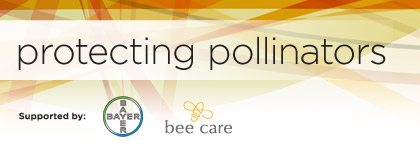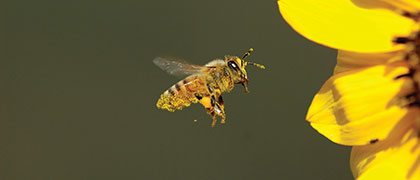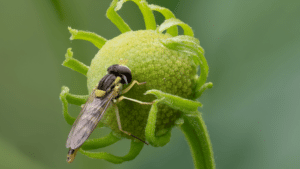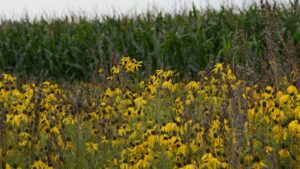Science and Stewardship
Over the course of Seed World’s Protecting Pollinators series, we have discussed the current state of honey bee health, the many stressors impacting honey bees, as well the different initiatives, both from the seed industry and non-industry, that are being undertaken to improve the health of honey bee colonies across the country. In the final installment of the Protecting Pollinators series we will examine the current initiatives aimed towards improving the relationship of honey bees and crop protection products.
The relationship between the honey bee and commercial agriculture’s chemical tools is an area where many stakeholders are collaborating in an attempt to investigate ways that will better allow these industry tools to be utilized concurrently without causing harm to beneficial insects or impacting production.
Apis mellifera, the honey bee, is inherently linked to agriculture through the dependence of many crops on the honey bee’s pollination services. At the same time, commercial agriculture is very much dependent on crop protection products in order to achieve the quality and yields needed to feed an ever-growing world population.
In the public arena, commercial agriculture’s chemicals tools have taken much of the blame for the decline in honey bee health. However, many scientist and regulatory authorizes throughout the country agree that bee health is impacted by a number of different factors that are culminating to cause a decline in health.
Furthermore, it has been stated by many researchers that the current state of knowledge on honey bee heath is truly in its infancy and many of the world’s leading research communities are in the beginning stages of coming together to develop solutions to better the landscape for both these irreplaceable pollinators as well as the country’s agricultural producers and beekeepers.
Blooming strips in front of the Bayer Bee Care Center in Monheim, Germany.
Bayer CropScience U.S. CEO Jim Blome cuts the ribbon at the opening of the bee health research facility in Clayton, NC.
Current Research Initiatives
Crop protectant products undergo extensive testing before being regulated for commercial use. However, Vicki Wojclk, research director with the Pollinator Partnership, the world’s largest organization devoted exclusively to pollinator conservation, says that a major factor in this research area is that most of these products are not required to be tested in conjunction with each other, which is an enormous factor in understanding how they impact non-target organisms.
“In terms of the synergistic effect of crop protectants, there is definitely a deficit in our understanding and we as an industry are definitely at a starting point,” says Wojcik. “These research avenues also intersect with regulation, which is sometimes difficult because much of the science in this area is inconclusive right now. It is a very difficult landscape, which makes finding these complex answers even more challenging.”
As challenging as the research may be, stakeholders continue to press forward, determined to find the answers and real-life solutions. “We need to know what the realistic conditions of these very low-level, chronic pesticide exposures are. How is that affecting [the bees’] pollination, their ability to find flowers and to reproduce,” adds Wojcik. “This research is certainly being done but it is a very slow and difficult process.”
Advancing Technologies
“Pollinators face the greatest threats from pesticides when they come in direct contact with the product or its residues, and the most common place that this interaction occurs is at a flower. Pesticides are never to be applied during bloom, but drift from an application site that is not in bloom onto adjacent areas that do have bloom can occur; this is the dominant cause of bee poisonings and kills. Having a seed
“Pollinators face the greatest threats from pesticides when they come in direct contact with the product or its residues, and the most common place that this interaction occurs is at a flower.”
|
that is treated as opposed to more traditional aerial modes of crop protectants should create a safer environment for pollinators because there is no spraying involved and exposure to drift and non-target effects should be reduced,” explains Wojcik.
Although neonicotinoid insecticides may get a bad rap, many industry professionals see their use as having revolutionized the ability to control damaging pests in a more environmentally-friendly way compared to the alternatives.
Agriculture chemical companies are always searching for routes to improve and do away with any residual effects and neonicotinods are no exception.
“There was an issue with the lubricant powder that helps the treated seed come out of the hopper. It was absorbing most of the crop protectant content and then causing it to become airborne,” says Wojcik. “Remedying this unintended circumstance is an urgent need as presently treated seeds are behaving much in the same way that aerial applications—and the drift issues they were intended to remove—do.”
Seed lubricant powders such as talc and graphite are commonly added to facilitate an even flow of seeds through the planter, and this can increase the total amount of dust inside the planter. Honey bees may potentially contact seed dust particles when the planter-emitted dust is airborne or after deposition on vegetation or other surfaces.
The Pollinator Partnership recently awarded a grant to the Corn Dust Research Consortium to enlist its expertise in researching this issue. “Beekeepers in Ohio and across the country have been hit by colony losses. Many factors have contributed to those losses—diseases, mites, and nutrition—but insecticidal seed treatment dust emanating from planters has the potential to increase colony loss,” explains Reed Johnson, assistant professor from Ohio State University. “The research by the CDRC will help us understand how bees in Ohio come into contact with this potentially deadly dust and allow us to identify management practices that could reduce bees’ exposure.”
The initial goal of this study is to develop a greater understanding of the use by bees of flowering cover crops and weeds in and around cornfields during spring planting season, and how this is influenced by vegetation management practices. Through this study, participants are also working to develop recommendations for best management practices that growers can follow in order to minimize exposure for foraging honey bees to seed dust while maintaining as much forage for honey bees as possible.
Researchers will also be evaluating the effectiveness of a new seed lubricant product from Bayer CropScience, by measuring deposition levels for pesticide dust in and around fields when commercially available neonicotinoid-treated corn seed products are planted using this new product in comparison to the industry’s standard lubricants.
“We are working to develop a replacement for the talc and graphite used by growers in pneumatic planters,” says Bill Hairston, director of product development with Bayer CropScience. “These current lubricants help reduce friction and improve uniformity of planting, but they can increase the amount of dust released from planter exhaust and raise the potential for unwanted exposure of seed treatment product to honey bees.”
The new Bayer fluency agent, which is made of a polyethylene wax substrate, was shown in lab testing to significantly decrease dust emissions from planters during planting. Throughout the creation process, Bayer conducted large-scale field studies, covering more than 40,000 acres throughout North America with growers and in collaboration with major planter manufacturers in the United States and Canada. Through this study, it was noted that there was a 90 percent reduction in total dust emissions versus the currently used talc agent. In comparison to the graphite agent, there was a 60 percent dust emission reduction.
Bayer CropScience, like many ag companies, has been working to improve dust control for a number of years through product formulations, modification of seed drillers, and continuous testing of various application techniques in order to find the best practices for limiting dust-off. “We have been working with planter manufacturers and hope to introduce this product for the 2014 planting season,” says Hairston.
Several research projects are underway to better understand the habits of pollinators and how they might come in contact with crop protection products.
Product Stewardship
Along with product development and searching for improved science, a number of initiatives are underway in the areas of best management practices and product stewardship.
“We are seeing a number of initiatives coming forward from all different stakeholders addressing stewardship and best management,” continues Wojcik. “We always stress critically assessing the need to apply the product first, but we also understand the complex interplay between protecting and promoting beneficial insects and preventing crop damage from pests. Although answers may not be coming to light as quickly as some would like, there is certainly no doubt that the industry is advancing on a number of fronts towards solutions that will better honey bee health and at the same time allow farmers the ability to produce yields that are demanded by our world’s growing population.
Tackling Honey Bee HealthBayer CropScience has an inherent interest in promoting and preserving bee health and they truly understand the important role honey bee pollination plays in sustainable agriculture. |




















